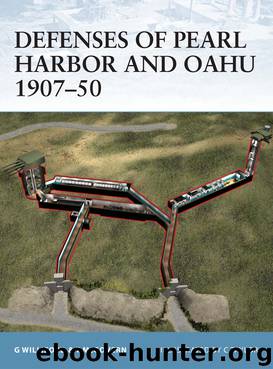Defenses of Pearl Harbor and Oahu 1907-50 by Glen Williford

Author:Glen Williford
Language: eng
Format: epub
Tags: Defenses of Pearl Harbor and Oahu 1907–50
ISBN: 9781472800626
Publisher: Osprey Publishing
Fire control station “B” on the summit of Puu Palailai. This was a four-tiered building with stations staggered in echelon. The top station was the Battle Command Station; the others were secondary stations for batteries Williston, Closson, and Hatch. The first three stations were constructed in 1929, and the fourth (for Hatch) added in 1934. The site served through World War II, but is now abandoned. (TM)
Initially the plans for this new generation of coast defenses did not include the overseas possessions and territories; thus the Hawaiian Islands were not included in the priority list. However, Oahu did receive additional armament, firstly for the new Kaneohe Bay Coast Defense Project, and then to augment and modernize the intermediate defense of the rest of the island.
Prior to 1941, the Oahu defenses were subdivided into two harbor schemes; the Harbor Defenses of Pearl Harbor, and those for Honolulu. At times these defenses were kept under separate commands (involving different forts, batteries, and sometimes regimental units), and during other periods they were combined. With the development of Kaneohe Bay into a major naval air base (and with minor naval traffic), the need for a new harbor defense was identified. In April 1941 the Hawaiian Separate Coast Artillery Brigade initiated a study on the defense of this new naval air station and nearby Bellows Field. The first request was for two 155mm batteries, two of the newest-type 6in. batteries, and one of the new-style 16in. casemated batteries. Eventually the project also called for 90mm and 37mm AA guns, searchlights, radars, fire control stations, and a harbor defense command post. By late 1942 construction permission had been granted for a modified program, and work was under way.
Kaneohe Bay was to be protected initially by three new batteries. Construction project number 301, a battery for two 6in. guns, was built on a small bluff at the southern side of the reservation of the naval base itself. Using cut-and-cover techniques, a battery close to the new standard type was constructed. The two 6in. m1903 guns on M1 shielded barbettes were placed 210ft apart, with a protected magazine and power room intervening. Exterior walls were of 6ft-thick concrete, with interior walls 18in. thick. The battery commander’s station was on the roof of the magazine, with the radar on top of that (the latter was built to resemble a water tank). The roof of the magazine was also 6ft thick, with another 3ft of earth covering. A small camp for the gun crew was built on the bluff behind the battery. Cost at completion was around $360,000.
Construction project number 302, also a battery for two 6in. guns, was built at Lae-o-Ka-Oio at the northern reaches of the bay. Unlike the practice on the mainland, the Hawaiian engineers showed great flexibility in modifying the plans to fit the local geographic conditions. The soft volcanic rock and rugged terrain lent themselves easily to tunneling – which in turn provided a lower cost and better protected alternative to the standard cut-and-cover designs.
Download
This site does not store any files on its server. We only index and link to content provided by other sites. Please contact the content providers to delete copyright contents if any and email us, we'll remove relevant links or contents immediately.
| Africa | Americas |
| Arctic & Antarctica | Asia |
| Australia & Oceania | Europe |
| Middle East | Russia |
| United States | World |
| Ancient Civilizations | Military |
| Historical Study & Educational Resources |
In Cold Blood by Truman Capote(3143)
Steve Jobs by Walter Isaacson(2767)
The Innovators: How a Group of Hackers, Geniuses, and Geeks Created the Digital Revolution by Walter Isaacson(2523)
All the President's Men by Carl Bernstein & Bob Woodward(2267)
Lonely Planet New York City by Lonely Planet(2110)
The Room Where It Happened by John Bolton;(2038)
And the Band Played On by Randy Shilts(2023)
The Poisoner's Handbook by Deborah Blum(1990)
The Murder of Marilyn Monroe by Jay Margolis(1985)
The Innovators by Walter Isaacson(1979)
Lincoln by David Herbert Donald(1875)
A Colony in a Nation by Chris Hayes(1802)
Under the Banner of Heaven: A Story of Violent Faith by Jon Krakauer(1689)
Amelia Earhart by Doris L. Rich(1589)
The Unsettlers by Mark Sundeen(1586)
Birdmen by Lawrence Goldstone(1536)
Dirt by Bill Buford(1525)
Zeitoun by Dave Eggers(1522)
Decision Points by George W. Bush(1466)
